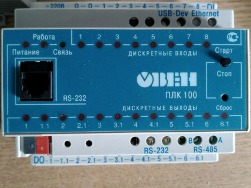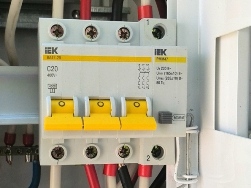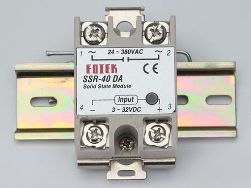 Recently, the topic of automation of various technological processes using programmable controllers (PLCs) has become increasingly popular. Despite this, there are very few practical articles on the Internet with real examples of how to program these PLCs. This topic is very interesting. Learning how to write PLC programs is possible even without them. The emulation mode, which is available in all modern software packages, helps a lot with this.
Recently, the topic of automation of various technological processes using programmable controllers (PLCs) has become increasingly popular. Despite this, there are very few practical articles on the Internet with real examples of how to program these PLCs. This topic is very interesting. Learning how to write PLC programs is possible even without them. The emulation mode, which is available in all modern software packages, helps a lot with this.
In this article I will show an example of translating an electrical circuit built on relay devices (starters, relays) into a program that will work on the controller. I must say right away that this is just a small educational project and does not pretend to explain anything more than just explaining the basic principles of PLC programming with a concrete example. The initial scheme for this project is a relatively simple scheme of a two-story linkage truck hoist ...
What are overvoltage and undervoltage releases and how are they used?
 Undervoltage and overvoltage releases are one of the types of additional devices for circuit breakers. They are designed to disconnect the load in the event of a voltage deviation from the nominal 220V. In this article I will talk about the method and circuit of connecting these devices, their advantages and disadvantages.
Undervoltage and overvoltage releases are one of the types of additional devices for circuit breakers. They are designed to disconnect the load in the event of a voltage deviation from the nominal 220V. In this article I will talk about the method and circuit of connecting these devices, their advantages and disadvantages.
The undervoltage and overvoltage release is one of the devices designed to control a circuit breaker. Almost every modern modular machine can connect additional devices. To do this, there is a plug on the side of the machine, unscrewing which you will see a lever for connecting such devices to the mechanical part of the power contact drive. If you press this lever with the cocked flag of the machine (ON), it will turn off. Additional devices such as this trip units and various devices ...
 In the early 1930s, Dr. Robert Van de Graaf, who at that time worked as a researcher at the Massachusetts Institute of Technology and was engaged in scientific research in the field of nuclear physics and accelerator technology, developed, designed, and soon built a high-voltage electrostatic accelerator operating on the principle of an electrified air ions conveyor belt (1933).
In the early 1930s, Dr. Robert Van de Graaf, who at that time worked as a researcher at the Massachusetts Institute of Technology and was engaged in scientific research in the field of nuclear physics and accelerator technology, developed, designed, and soon built a high-voltage electrostatic accelerator operating on the principle of an electrified air ions conveyor belt (1933).
Later, in 1936, Van de Graaff built (all on the same principle) the world's largest electrostatic constant voltage generator - the Van de Graaff tandem generator, consisting of two high towers. Newspapers of that time called the invention of an associate professor nothing short of revolutionary, predicted him to "perform miracles" and "discover the secrets of nature." Such a strong hype in the press is not at all surprising, because the largest two-stage generator consisted of ...
What cable can be used outdoors and how to lay it
 When arranging a pre-precinct, there is a need to conduct light into the gazebo, garage and outbuildings. The novice master is faced with the problem of choosing cable products that would serve for a long time both under the scorching sun and in severe frost. Therefore, we have put together recommendations for choosing cables for outdoor use.
When arranging a pre-precinct, there is a need to conduct light into the gazebo, garage and outbuildings. The novice master is faced with the problem of choosing cable products that would serve for a long time both under the scorching sun and in severe frost. Therefore, we have put together recommendations for choosing cables for outdoor use.
There are a number of dangerous factors for cable on the street. Consider them and how to deal with them. When laying outdoors, bear in mind that during the storm the cable will be subjected to stresses such as stretching and jerking. The insulation of most modern products can be operated in frosts from -15 to -25.Consider this fact if you live in regions where there are severe frosts with temperatures below those indicated. Ultraviolet is perhaps the most important enemy of isolation. Under the influence of ultraviolet it is impossible to see how it is destroyed. After all, this process is happening gradually ...
Errors in wiring in corrugation
 Modern electricians lay wiring in the corrugation on the street, indoors, on the surface and inside the walls. Despite all the advantages of this installation method, there are a number of features of its use. The fact is that there are three varieties of corrugations and each of them is intended for use for certain purposes. In this article we will look at typical errors when laying cables and wires in the corrugation.
Modern electricians lay wiring in the corrugation on the street, indoors, on the surface and inside the walls. Despite all the advantages of this installation method, there are a number of features of its use. The fact is that there are three varieties of corrugations and each of them is intended for use for certain purposes. In this article we will look at typical errors when laying cables and wires in the corrugation.
Types of corrugation Strange as it may sound, but the corrugation is chosen by color. There are three main materials for the production of corrugated pipes, in order to prevent mistakes in the future, remember: white or gray - polyvinyl chloride (PVC), black or orange - low pressure polyethylene (HDPE), blue - polypropylene (PPR). What is the difference between corrugations? PVC corrugations are used indoors, and they crack due to ultraviolet radiation. But this material does not support combustion. The mechanical strength is lower than that of analogues ...
How to connect incremental encoder to Arduino
 Often in devices on microcontrollers you need to organize the management of menu items or implement some adjustments. There are many ways: use buttons, variable resistors, or encoders. The incremental encoder allows you to control something by means of the endless rotation of the handle. In this article, we will look at how to make the incremental encoder and Arduino work.
Often in devices on microcontrollers you need to organize the management of menu items or implement some adjustments. There are many ways: use buttons, variable resistors, or encoders. The incremental encoder allows you to control something by means of the endless rotation of the handle. In this article, we will look at how to make the incremental encoder and Arduino work.
The incremental encoder, like any other type of encoder, is a device with a rotating handle. Distantly, it resembles a potentiometer. The main difference from the potentiometer is that the encoder handle rotates 360 degrees. He has no extreme provisions. Encoders come in many types. Incremental differs in that with its help it is impossible to know the position of the handle, but only the fact of rotation in some direction - to the left or to the right. By the number of signal pulses, you can already calculate at what angle it turned ...
Electrostatic Generator Testatica
 At the end of the twentieth century, the leader of the spiritual community of Methernita, Paul Baumann, developed a very unusual electric power generator, which was called “Testatika”.
At the end of the twentieth century, the leader of the spiritual community of Methernita, Paul Baumann, developed a very unusual electric power generator, which was called “Testatika”.
The generator operated thanks to the high voltage generated by the modified Wimshurst machine, and served to convert static electricity received directly from the air surrounding the machine into direct voltage and current. And although the concept of creating a machine was originally based on the idea of using as simple and affordable elements as possible in its design, generators of this type, with disks with a diameter of 50 to 200 cm, rated power up to 30 kW, have successfully provided all the needs of the community for electricity for the past more than three decades. Instead of Leiden cans, similar to those that can be found in the designs of ordinary electrophore machines ...
What is a solid state relay and how to use it correctly
 In all electrical circuits have to turn on and off the instruments and devices. To do this, use switching devices, it can be either a simple switch or switch, or relays, contactors, etc. Today we will consider one of such devices - a solid-state relay, let's talk about what it is like to select and connect to a load control circuit.
In all electrical circuits have to turn on and off the instruments and devices. To do this, use switching devices, it can be either a simple switch or switch, or relays, contactors, etc. Today we will consider one of such devices - a solid-state relay, let's talk about what it is like to select and connect to a load control circuit.
A solid state relay is a device built on semiconductor elements and power switches, such as triacs, bipolar or MOS transistors.In English sources, solid state relays are called SSRs from Solid State Relay (which is literally equivalent to the Russian name). Conventional relays, like all electromagnetic switching devices, work as follows - there is a coil to which current is supplied from the control system or the push-button station.As a result of the current flowing through the coil, a magnetic field arises that attracts the armature ...
